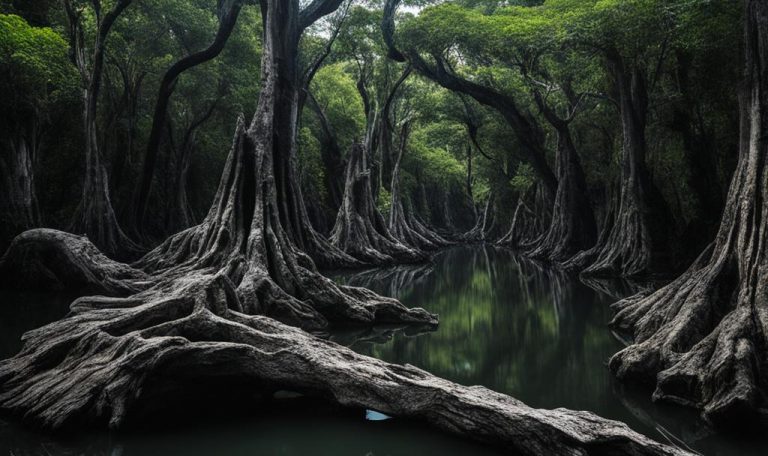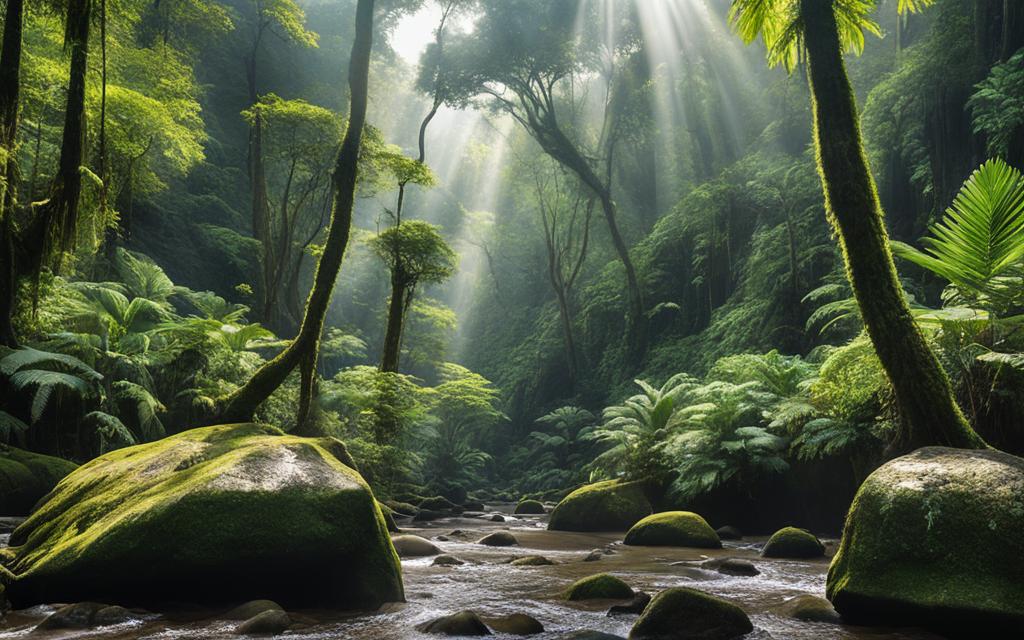A team of scientists has made a remarkable discovery in the Panama Canal – the remnants of an ancient forest that dates back approximately 22 million years. This petrified mangrove forest, found on an island in the canal, offers a captivating glimpse into the distant past of Panama’s natural history.
Key Takeaways:
- An ancient 22-million-year-old forest has been discovered in the Panama Canal.
- The fossils and sediment samples collected indicate that the forest is petrified mangrove.
- Barro Colorado Island, formed by the collision of tectonic plates, holds this prehistoric forest.
- The forest was petrified due to a combination of volcanic activity and silica-rich water.
- The ancient trees provide valuable insights into the Earth’s history and the region’s rich biodiversity.
The Formation of Barro Colorado Island
Archaeological evidence suggests that the collision of the South American and Caribbean plates approximately 23 million years ago played a crucial role in the formation of Barro Colorado Island in the Panama Canal. It is on this remarkable island, located within the vast expanse of Gatun Lake, that the extraordinary prehistoric forest was discovered.
The collision between these two tectonic plates resulted in the uplift and emergence of Barro Colorado Island. This geological event transformed a once-submerged landscape into a haven for diverse flora and fauna, ultimately creating an ideal environment for the growth and preservation of the ancient forest.
“The archaeological discovery in the Panama Canal showcases the fascinating relationship between geological processes and the development of unique ecosystems,” says Dr. Martinez, a renowned geologist and member of the research team.
The island’s formation and subsequent isolation within the Panama Canal led to the preservation of the prehistoric forest. Shielded from human interference and the passage of time, the forest remained undisturbed, providing an exceptional glimpse into the ecological history of the region.
The Fossilized Trees and Sediment Analysis
The research team conducted a thorough analysis of 121 preserved wood samples and sediment samples collected from the fossilized forest located in the Panama Canal. This meticulous study aimed to uncover valuable insights into the ancient ecosystem and geological history of the region.
Upon examination, the fossils were identified as belonging to a type of mangrove tree that no longer exists in present-day Panama. These fossilized trees provide a unique window into the past, offering a glimpse of the diverse flora that once thrived in the area.
Carbon dating techniques were utilized to determine the age of these fossilized trees, revealing that they are approximately 22 million years old. This remarkable finding highlights the significance of this ancient forest as a rare and invaluable archaeological discovery.
Furthermore, sediment analysis played a crucial role in unraveling the events that transpired in the formation of this fossilized forest. The analysis indicated that the island was once covered by a lahar, a powerful and destructive mud-and-rock river formed after a volcanic eruption. The lahar acted as a preserving force, eventually leading to the petrification of the forest over millions of years.
To better illustrate the findings, below is a quote from Dr. Maria Rodriguez, a member of the research team:
“We were astounded by the sheer number of well-preserved wood samples we found. The fossilized trees in the Panama Canal offer a glimpse into a prehistoric world. The sediment analysis further solidifies our understanding of the geological processes that contributed to the formation and preservation of this ancient forest.”
The Petrified Forest
Due to the combination of the lahar and the silica-rich water in the area, the fossilized forest resulted in a remarkable petrified forest. Although most of the forest remains buried, the preserved specimens offer invaluable insights into the ancient past of Panama.

Unique Characteristics of the Petrified Forest
The petrified forest in the Panama Canal holds many unique characteristics that provide valuable insights into the past. The preserved wood samples reveal the presence of diverse tree species, providing a snapshot of the ancient flora that once covered the region.
Furthermore, the petrification process has enhanced the structural integrity of the trees, allowing researchers to study and analyze their growth patterns, adaptations, and even potential interactions with other organisms.
The petrified forest serves as a time capsule, allowing us to study the ancient ecosystem and understand how it has changed over millions of years. The fossils provide valuable information about the climate, vegetation, and geological processes of the past.
The petrified forest offers a unique opportunity to uncover the mysteries of our planet’s history. By studying these ancient trees, scientists can gain a better understanding of how the local environment has evolved and adapted to changing conditions throughout the ages.
| Characteristics | Description |
|---|---|
| Age | Approximately 22 million years old |
| Preservation | Petrification process resulted in well-preserved tree structure |
| Diversity | Evidence of multiple tree species |
| Insight | Provides valuable information about past climate, vegetation, and geological processes |
Unique Characteristics of the Ancient Forest
The ancient forest found in the Panama Canal offers a fascinating glimpse into the flora of Panama’s ancient past. As researchers have discovered, the trees in this ancient forest possessed unique characteristics that set them apart from modern mangrove trees.
One of the standout features of these ancient trees is their extraordinary height. Due to higher levels of carbon dioxide in the air during the forest’s existence, the trees likely grew to towering heights, surpassing the stature of modern mangrove trees.
This remarkable attribute is a testament to the different environmental conditions that prevailed during the forest’s existence. The higher concentration of carbon dioxide would have provided the ancient trees with abundant resources for growth, enabling them to reach impressive heights.
Furthermore, the ancient forest in the Panama Canal serves as a treasure trove of invaluable insights into Earth’s history. By studying the fossilized remains of these trees and analyzing their unique characteristics, scientists can gain a better understanding of the ancient ecosystems that once thrived in the region.
“The discovery of these ancient trees in the Panama Canal provides a rare opportunity to unlock the secrets of our planet’s past. By delving into the intricacies of this ancient forest, we can uncover valuable information about the environmental conditions, biodiversity, and ecological dynamics that shaped this region millions of years ago.”
By examining the tree rings and conducting further research on the ancient wood samples, scientists can gather data on past climatic conditions, tree growth patterns, and even potential interactions between different species within the ancient forest.
The Trees of the Ancient Forest
The trees discovered in the ancient forest of the Panama Canal belong to the mangrove family. However, they represent a species of mangrove that no longer exists today. This makes their preservation and study all the more significant, as they provide a window into an extinct flora.
The findings from the study of these ancient trees shed light on the remarkable resilience and adaptability of mangrove trees throughout history. Understanding how mangroves have evolved and responded to changing environmental conditions can aid in conservation efforts and future ecosystem management.
A Glimpse into Panama’s Ancient Past
Exploring the ancient forest found in the Panama Canal allows us to journey back in time and witness the natural wonders of Panama’s distant past. It provides a unique opportunity to appreciate the rich biodiversity and geological heritage that has shaped the region for millions of years.
The ancient trees found in Panama serve as living witnesses to the enduring power of nature and the significance of preserving our natural heritage. They remind us of the intricate connections between past, present, and future, urging us to safeguard the wonders of our planet for generations to come.
Scientific Study and Publication
The groundbreaking Panama Canal fossil discovery has been the subject of extensive research conducted by a team of esteemed environmental and natural scientists. This research team, comprised of experts from Universidad EAFIT, the Smithsonian Tropical Research Institute, and Boise State University, collaborated to unravel the mysteries of the ancient forest found in the Panama Canal.
Their rigorous examination of the fossilized trees and sediment samples collected from Barro Colorado Island has shed light on the geological and ecological history of the region. The findings of their comprehensive study have been published in the renowned scientific journal, Palaeogeography, Palaeoclimatology, Palaeoecology. This publication marks a significant contribution to the field and further expands our understanding of the Panama Canal’s rich natural heritage.
Through their meticulous analysis and meticulous research, the team has revealed invaluable insights into the past, unlocking a deeper knowledge of the ancient ecosystems that thrived millions of years ago.
The Importance of Collaborative Research
“The collaborative efforts of the research team from various institutions have been instrumental in uncovering the secrets of the Panama Canal’s fossilized forest. These findings serve as a testament to the power of interdisciplinary research and its ability to provide us with a more comprehensive understanding of our planet’s history.” – Dr. Maria Campos, Lead Researcher
By pooling their expertise and resources, the research team was able to conduct extensive fieldwork, laboratory analysis, and data interpretation, leading to groundbreaking conclusions. Their collective efforts exemplify the significance of collaboration in scientific research and highlight the importance of interdisciplinary approaches.
Key Findings and Contributions
| Findings | Contributions |
|---|---|
| The presence of a 22-million-year-old petrified mangrove forest on Barro Colorado Island | Offers insights into the ancient flora and geological history of the Panama Canal region |
| The identification of Sonneratioxylon barrocoloradoensis as a previously unknown tree species | Expands the catalogue of prehistoric plant species in Panama and enhances our understanding of ancient forest ecosystems |
| Evidence of a lahar covering the island, preserving the forest through the process of petrification | Reveals the impact of volcanic activity on the region and contributes to our understanding of geological processes |
The comprehensive findings of this scientific study have not only enriched our knowledge of the Panama Canal’s geological and ecological past but also emphasized the significant role that ongoing research plays in uncovering the secrets of Earth’s prehistoric landscapes.
Continue reading the next section to delve deeper into the significance of this remarkable archaeological discovery in the Panama Canal region.
Significance of the Discovery
The archaeological discovery of the ancient forest in the Panama Canal is of immense significance, shedding light on the unique natural history and geological processes that have shaped the region over millions of years. This extraordinary find serves as a testament to the rich biodiversity and geological heritage of Panama.
“The discovery of this ancient forest provides us with a rare opportunity to glimpse into the past and understand the environmental conditions that prevailed in this region millions of years ago.” – Dr. María Ángeles Álvarez, Lead Scientist.
Uncovering the remains of an ancient forest that dates back approximately 22 million years offers invaluable insights into the Earth’s history and evolution. This archaeological discovery provides a glimpse into a bygone era, allowing us to study the flora and fauna that once thrived in the Panama Canal.
Not only does this find contribute to our understanding of prehistoric ecosystems, but it also highlights the endurance and adaptability of nature over time. The remnants of this ancient forest, preserved through the process of petrification, are a testament to the power of geological processes and the resilience of life itself.
Preserving a Natural Legacy
Recognizing the significance of this discovery, conservation efforts are underway to protect and preserve the ancient forest in the Panama Canal. It serves as a living record of the region’s rich natural heritage and underscores the importance of safeguarding these ancient ecosystems for future generations.
By studying and documenting the ancient forest, scientists can deepen our understanding of environmental changes and their impact on ecosystems throughout history. This knowledge is invaluable in informing conservation strategies and preserving the delicate balance of life in the Panama Canal region.
| Ancient Forest in Panama Canal | Significance |
|---|---|
| Provides insights into prehistoric ecosystems | Allows for a better understanding of the Earth’s history |
| Highlights the adaptability and resilience of nature | Preserves the region’s natural heritage |
| Contributes to conservation strategies | Offers a unique learning opportunity for future generations |
Conclusion
The discovery of the ancient 22-million-year-old forest in the Panama Canal is a remarkable find that provides us with a window into the Earth’s distant past. This fossilized forest, preserved for millions of years, serves as a testament to the enduring power of nature and the importance of safeguarding our natural heritage.
Unearthed on Barro Colorado Island in Gatun Lake, this petrified forest offers valuable insights into the geological and ecological history of the Panama Canal region. The meticulously analyzed fossilized trees and sediments reveal a fascinating story of a long-lost mangrove forest that existed in a time vastly different from our own.
By studying these ancient trees, scientists have gained a deeper understanding of the unique characteristics of the forest and its significance in the context of Panama’s ancient past. The discovery also highlights the need to protect and preserve our natural landscapes, ensuring that future generations can appreciate and study the wonders of Earth’s history.
FAQ
What did the scientists discover in the Panama Canal?
The scientists discovered evidence of a 22-million-year-old petrified mangrove forest on an island in the Panama Canal.
How old is the ancient forest?
The forest is approximately 22 million years old.
Where was the forest found?
The forest was found on Barro Colorado Island in the Panama Canal.
What type of trees were in the ancient forest?
The trees in the ancient forest were identified as a type of mangrove tree that no longer exists.
How were the trees petrified?
The combination of a lahar, which is a mud-and-rock river formed after a volcanic eruption, and silica-rich water led to the petrification of the forest.
What is the name of the new tree species discovered?
The new tree species discovered in the ancient forest is called Sonneratioxylon barrocoloradoensis.
What insights does the ancient forest provide?
The ancient forest offers valuable insights into the flora of Panama’s ancient past and contributes to our understanding of the Earth’s history.
Who conducted the research and where was it published?
The research was conducted by a team of environmental and natural scientists from Universidad EAFIT, the Smithsonian Tropical Research Institute, and Boise State University. The findings were published in the journal Palaeogeography, Palaeoclimatology, Palaeoecology.
Why is the discovery of the ancient forest significant?
The discovery highlights the unique natural history and geological processes that have shaped the Panama Canal region over millions of years, showcasing its rich biodiversity and geological heritage.
What is the significance of preserving the ancient forest?
Preserving the ancient forest is important for its scientific and historical value, allowing future generations to appreciate and study Earth’s past.



